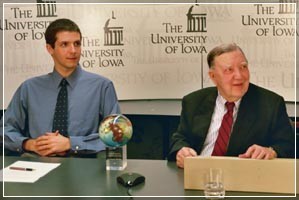National Space Grant Distinguished Service Award

Dr. James A. Van Allen | 2004
Born on September 7, 1914, in Mount Pleasant, Iowa, Dr. James A. Van Allen showed an interest in mechanisms and devices at an early age. He enjoyed science, math, and mechanical skills in high school, which he completed in June 1931 as class valedictorian. He entered Iowa Wesleyan College in the fall of 1931 (paying tuition of $45 per semester ). After taking all of the physics, chemistry, and mathematics courses available, he completed his undergraduate work and graduated summa cum laude in 1935. He then entered the University of Iowa where he received an M.S. in 1936 and his Ph.D. in 1939.
Following school, Van Allen accepted employment with the Department of Terrestrial Magnetism at the Carnegie Institution of Washington. In April 1942 Van Allen moved to the Applied Physics Laboratory at Johns Hopkins University. He was commissioned in the U.S. navy in the fall of 1942 and served in the Pacific. Upon completing his assignments in World War II, Van Allen returned to civilian life and began working in high altitude research, first for the Applied Physics Laboratory and, after 1950, at the University of Iowa.
Dr. Van Allen’s career took an important turn in 1955 when he and several other American scientists developed proposals for the launch of a scientific satellite as part of the research program conducted during the International Geophysical Year (IGY) of 1957–1958. After the success of the Soviet Union with Sputnik 1, Van Allen’s Explorer spacecraft was approved for launch on a Redstone rocket. It flew on January 31, 1958 and returned enormously important scientific data about the radiation belts circling the Earth. Van Allen became a celebrity because of the success of that mission, and he went on to other important scientific projects in space. In one way or another, Van Allen was involved in the first four Explorer probes, the first Pioneers, several Mariner efforts, and the orbiting geophysical observatory. James A. Van Allen retired from the University of Iowa in 1985 to become Carver Professor of Physics, Emeritus, after having served as the head of the Department of Physics and Astronomy since 1951. His most recent technical publication is: J. A. Van Allen and W. R. Webber, “Observed Solar Modulation of Galactic Cosmic Ray Intensity in the Outer Heliosphere,” Geophysical Research Letters, Vol. 29, No. 7, 10.1029/2001GLO14099, 2002.
Throughout his career and continuing after his retirement, Dr. Van Allen has worked with young people to encourage them to pursue careers in science. It is for his tireless work as a mentor and example of life-long learning and discovery that he is honored tonight.
Adapted from “What is a Space Scientist?,” James A. Van Allen, originally published by Annual Reviews Inc. in the Annual Review of Earth and Planetary Sciences, 18, 1–26, 1990, and from NASA Headquarters, Public Affairs Web Site.


